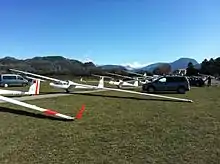Glasflügel 604
The Glasflügel 604 is a high-wing, T-tailed, single seat, FAI Open Class glider that was designed and produced in West Germany by Glasflügel starting in 1970.[1][2]
| Glasflügel 604 | |
|---|---|
.jpg.webp) | |
| Role | Glider |
| National origin | West Germany |
| Manufacturer | Glasflügel |
| First flight | early 1970 |
| Introduction | 1970 |
| Status | No longer in production |
| Number built | 11 |
| Developed from | Glasflügel Kestrel 17 |
Developed from the Kestrel 17, the 604 is often erroneously called a Kestrel 22 despite the company never giving it a formal name beyond its number designation.[2]
Design and development
The 604 was originally intended as a test aircraft for a proposed two-seat glider that was never built. The prototype did so well in competition that a ten-aircraft production run was completed, resulting in a total of eleven 604s being completed.[1][2]
Due to the aircraft's huge size, including its 22.0 m (72.2 ft) three-piece wing that weighs over 272 kg (600 lb), the aircraft picked up the nickname "the Jumbo". The wing centre section alone weighs 115 kg (254 lb), requiring a large crew in order to rig it for flight.[2]
The 604 is constructed from fibreglass. The wing employs a modified Wortmann FX 67-K-170 airfoil at the wing root, changing to a Wortmann FX 67-K-150 at the wing tip. The wing features six flaps, with the outer pair moving at a 2:1 differential ratio with the ailerons. For glidepath control, the 604 has wing top-surface spoilers and a tail-mounted drag chute. The aircraft can carry 100 kg (220 lb) of water ballast. The landing gear is a retractable monowheel.[1][2][3]
Operational history

The 604 prototype, flown by Walter Neubert, came in sixth in the 1970 World Gliding Championships held at Marfa, Texas, even though the pilot was lost overnight after a land-out during the competition and missed the following day. A 604 came second in the Open Class at the 1974 World Championships held at Waikerie, South Australia. The aircraft also set several world records between 1970 and 1974.[1][2]
In 1981, Marion Griffith Jr. flew a 604 for 645 mi (1,038 km) from Refugio, Texas to Liberal, Kansas to win the Barringer Trophy, while also setting a US distance to a goal record.[4]
In July 2011, five of the eleven 604s built were located in the United States and registered with the Federal Aviation Administration in the Experimental - Racing/Exhibition category.[5]
Specifications (604)
Data from Sailplane Directory and Soaring[1][2]
General characteristics
- Crew: one
- Wingspan: 22.0 m (72 ft 2 in)
- Wing area: 16.3 m2 (175 sq ft)
- Aspect ratio: 29.8:1
- Airfoil: Wing root: Wortmann FX 67-K-170 mod, wing tip: Wortmann FX 67-K-150
- Empty weight: 420 kg (926 lb)
- Gross weight: 600 kg (1,323 lb)
Performance
- Never exceed speed: 249 km/h (155 mph, 135 kn) in rough air
- Maximum glide ratio: 49:1 at 61 mph (98 km/h)
- Rate of sink: 0.50 m/s (98 ft/min) at 45 mph (72 km/h)
- Wing loading: 37.0 kg/m2 (7.57 lb/sq ft)
See also
Aircraft of comparable role, configuration, and era
Related lists
References
- Activate Media (2006). "604 Glasflugel". Archived from the original on 25 August 2012. Retrieved 11 July 2011.
- Said, Bob: 1983 Sailplane Directory, Soaring Magazine, page 81, Soaring Society of America November 1983. USPS 499-920
- Lednicer, David (2010). "The Incomplete Guide to Airfoil Usage". Archived from the original on 20 April 2010. Retrieved 11 July 2011.
- Griffith Jr., Marion (February 1982). "645 Miles in a 604". Soaring. 46 (2): 41–44.
- Federal Aviation Administration (July 2011). "Make / Model Inquiry Results Glasflugal 604". Retrieved 11 July 2011.